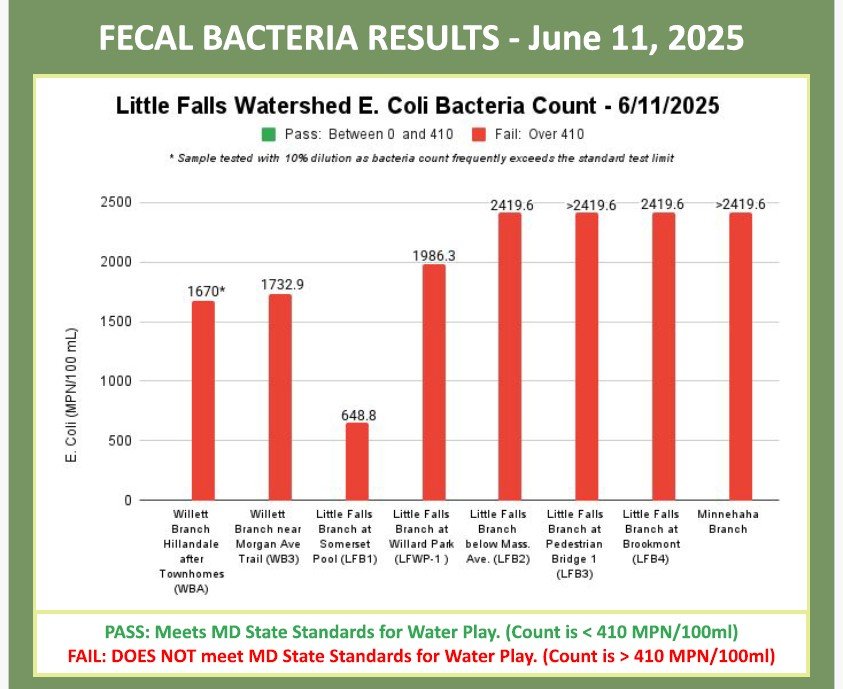2025 Bacteria Quality Report
2025 Testing Locations
Click on the map locations for more information on each site.
What does “FAIL” mean for playing in the water?
From the Montgomery County Department of Environmental Protection website:
Stay Safe!
To mitigate the public health threat it is recommended that residents should:
Avoid physical contact with the stream water
Avoid wading in the water
Keep pets out of the water
Avoid drinking stream water or touching stream water
Wash hands should physical contact occur and before eating
Avoid water contacting an open cut, wound or skin infection
Pay attention and follow advisory signs
Common Illnesses
The most common health implications or illness associated with contaminated water include:
gastroenteritis (nausea, vomiting, headache, stomachache, fever and diarrhea)
ear, nose, and throat infections
rashes
wound infections through an open cut or wound
Keep in mind that contaminants can find their way into all waterways, so there is always a risk for infections, especially for those who have chronic illnesses.
UPDATES
LFWA Monitoring program
By testing for bacteria, we hope to inform residents of the safety of the water for splashing and wading as well as determine if there is a need for sewer line repairs in the watershed. Volunteers also test the pH and measure air and water temperature. The samples are analyzed at a water quality lab run by Anacostia Riverkeeper. Results are posted on our Facebook page, on kiosks close to the creek, on community listservs, on TheSwimGuide.org, and on our website.
2025 Testing dates - every Wednesday, June 4 to September 3
2025 Locations (as shown on the map)
Willett Branch off the Little Falls Hiker/Biker Trail by Morgan Drive – WB3
Willett Branch at the end of Willett Parkway where path curves to Norwood Park – WBA
Little Falls Branch upstream from the Somerset pool – LFB1
Little Falls Branch at the Willard Avenue Neighborhood Park - LFWP-1
Little Falls Branch downstream from Mass. Ave. bridge at the second bench – LFB2
Little Falls Branch downstream from Mass. Ave. bridge at the first pedestrian bridge – LFB3
Little Falls Branch on Potomac River side of MacArthur Blvd in Brookmont – LFB4
Minnehaha Branch in Glen Echo Park – MB1
what is fecal bacteria?
Fecal coliform bacteria are found in the feces of warm-blooded animals such as people, pets, and wildlife. Fecal coliform contamination in streams can come from leaking sewer pipes and many small sources such as pet waste in stormwater runoff. Wildlife and birds also contribute. As the amount of fecal coliform bacteria in the water increases, the risk of contracting a waterborne illness increases.
Fecal bacteria Health risks
The best indicator of the health risk from recreational water contact is E. coli, which is a species of fecal coliform bacteria that is specific to fecal material from humans and other warm-blooded animals. The presence of E. coli is also used as an indicator to monitor the possible presence of other more harmful microbes, such as Cryptosporidium, Giardia, Shigella, and norovirus. Some of the symptoms of illness associated with fecal coliform bacteria contamination are upset stomach, diarrhea, ear infections, and rashes. However, some bacteria, such as some strands of E coli, hepatitis, and Salmonella, can have very severe health effects.
Fecal Coliform Creates Problems for fish and Aquatic Plants
High levels of fecal coliform can cause other problems as well. Sewage and other contaminants contain nitrogen and phosphorus, which act as fertilizer for algae and other aquatic plants. An overgrowth of plants can deplete dissolved oxygen needed by fish and other aquatic animals. affect the natural acidic-alkaline (pH) balance of water, create odor problems, and affect property values.
The possibility of bacterial contamination increases in the summer months, which is also the time when more people come in contact with the streams in the watershed.
2025 Trend Charts
🟩 Pass: E. coli between 0-410 per 100mL 🟥 Fail: E. coli above 410 per 100mL
Geometric mean represents the average bacteria level of all the dates listed. We are using 2,420 for samples that exceeded test limit to calculate/estimate the geometric mean. This means the actual geomean is higher.
*The scale of y-axis for Figures 1 and 2 are higher than the other sites.
Historical Data
2025 results
2025 Monitoring Results are HERE.
2025 Water Quality Report is HERE
2024 Results
2024 Monitoring Results are HERE.
2024 Water Quality Report is HERE.
2023 Results
2023 Water Quality Report is HERE.
2022 Results
READ the Complete Report Here.
Summer 2022 results from 7 sites along the Little Falls and Willett Branches. Complete data with rainfall levels.
willett Branch results 2021-22 fall/winter/spring
Bacteria levels in the Willett Branch during the summer of 2021 consistently exceeded 2420 MPN/100 ml. So, in October of 2021 and February and April of 2022, we tested the Willett Branch periodically to see how the numbers looked in the “off season”. We also tested with a 10% dilution test, so that we could see real numbers. And we added an upstream site on the Willett Branch, above Hillandale (WBA).
Click HERE For results; Click HERE for map of locations.
2021 Results
Click HERE for a report of our 2021 findings
LFWA monitored sites along with Little Falls and Willett Branches from July to September.
2020 Results
In September 2020, LFWA volunteers collected water samples at 5 locations to test for E. coli concentrations. E Coli concentrations were HIGH at some of the locations.
Click for the September 2020 report
2009-2012 Results
By Court decree, WSSC monitored the watershed between 2009 and 2012. They did a DNA testing and found high levels of human fecal matter as well as fecal matter from dogs, deer, birds and other wildlife.





